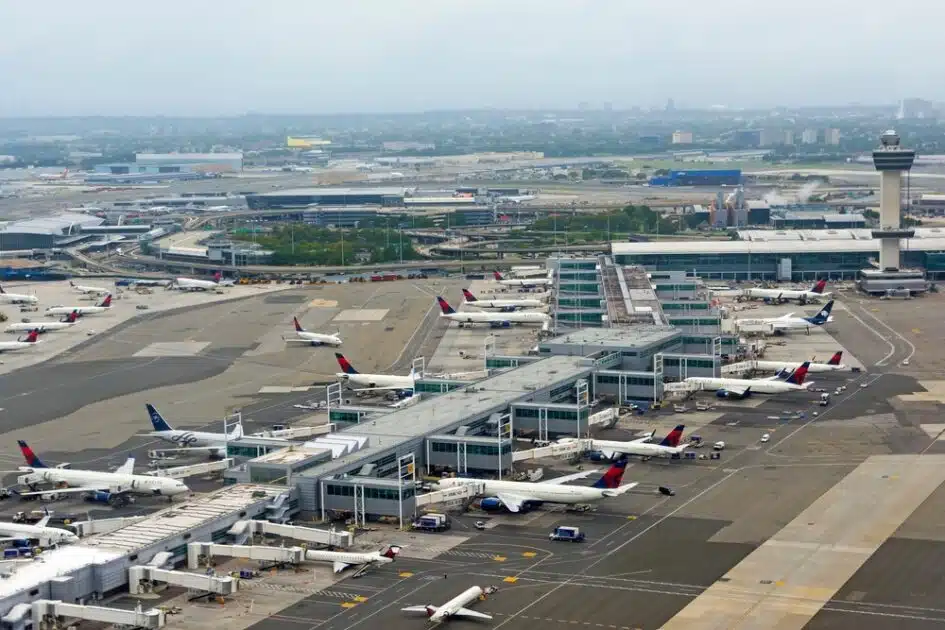Airline Statistics 101 How Many Flights A Day (Updated 2024)

Commercial flights, passenger statistics, airports, number of planes in the air and more!
Gay Friendly Travel Guides 27th May, 2022
Air travel has become an integral part of modern life, connecting people to different parts of the world and facilitating international trade and commerce. As the aviation industry continues to grow, it becomes increasingly important to understand the various statistics and metrics that govern the operations of airlines.
One such statistic is the number of flights per day, which is a key indicator of an airline’s scale, reach, and efficiency.

In this article, we will explore the concept of flights per day in more detail, discussing the factors that affect this metric, examples of airlines with varying numbers of flights per day, and where to access information on airline flight schedules.
By the end of this article, you will have a better understanding of the importance of airline statistics, and how the number of flights per day plays a crucial role in shaping the performance and competitiveness of airlines in today’s globalized world.
How Many People Have Ridden An Airplane Ever?
Admittedly, plane flights are not cheap; however, it is also probably the easiest and quickest method of travel when going long distances.
Some people basically live in airports because their work demands go from one state to another. At the same time, other people have never stepped on an airport, let alone ridden a plane.
People also have different reasons for riding a place – from visiting a vacation destination, visiting family for the holidays, or attending a work convention.
Here Are Interesting Statistics About People Who Ride Airplanes
- In a 2017 report, a staggering 80% of the total global population has never taken a flight, and only 20% (1.5 billion) have.
- In 2019, 40% of the American population had never left their country, while 13% had never ridden a plane.
- In 2019, Asia Pacific had the highest share of airline passenger traffic. This accounts for a third of the global total.
- In 2019, there were 38.9 million flights performed globally.
- In 2020, 2,900,000 passengers flew in and out of US airports.
- There was a total of 176 fatalities due to air crashes in 2021.
Factors Affecting the Number of Flights per Day
Air travel has become an essential part of modern-day transportation, connecting people and places worldwide. The number of flights per day is a key metric in the aviation industry, reflecting the demand for air travel and the capacity of airports and airlines to meet that demand.
Here are some of the factors that can affect the number of flights per day, backed by relevant statistics.
- Airlines’ Size and Flight Schedule
The number of flights per day that an airline operates is often dependent on the size of the airline and its flight schedule. A larger airline with more resources may operate more flights per day compared to a smaller airline with fewer resources. Additionally, airlines with a more extensive flight schedule may offer more flights per day to specific destinations. - Peak Travel Season
The number of flights per day often increases during peak travel seasons, such as holidays or summer months when more people are traveling. Airlines may add more flights per day to meet the demand for air travel during these busy times. - Hub Airports
Airlines often have “hub” airports where they operate more flights per day than at other airports. These airports serve as central locations for the airline, allowing for more efficient connections and transfers for passengers. Airlines may also offer more flights per day to popular destinations from their hub airports. - Impact of the COVID-19 Pandemic
The COVID-19 pandemic has had a significant impact on the number of flights per day that airlines operate. Due to travel restrictions and reduced demand for air travel, many airlines have reduced their flight schedules, resulting in fewer flights per day. Some airlines have also ceased operations altogether, further reducing the number of flights per day.
According to the International Air Transport Association (IATA), global air passenger traffic decreased by 65.9% in 2020 compared to 2019. As a result, many airlines reduced their flight schedules, and some airports closed temporarily.
The number of flights per day that airlines operate is influenced by several factors, including the size of the airline, its flight schedule, peak travel seasons, hub airports, and the impact of the COVID-19 pandemic. These factors can impact both the number of flights offered by an airline and the number of flights departing from a particular airport.
Example of Number of Flights per Day
When comparing the number of flights per day among different airlines, it’s important to consider factors such as airline size, flight schedule, and destinations served. For example, as of 2021, American Airlines operates an average of 5,400 flights per day, while Delta Air Lines operates an average of 4,400 flights per day.
However, Southwest Airlines, a smaller airline, operates an average of 4,000 flights per day, showing that airline size is not the only factor influencing the number of flights per day.
Examples of Airlines’ Hub Airports and Their Number of Flights per Day
Airlines often operate more flights per day from their hub airports, which are central locations for their operations. For example, as of 2021, United Airlines operates an average of 3,400 flights per day from its hub airport, Chicago O’Hare International Airport.
Similarly, Delta Air Lines operates an average of 1,000 flights per day from its hub airport, Hartsfield-Jackson Atlanta International Airport.
Changes in Number of Flights per Day Due to the COVID-19 Pandemic
The COVID-19 pandemic has significantly impacted the number of flights per day that airlines operate. For example, in April 2020, American Airlines reduced its daily flight schedule by 60% compared to the previous year due to decreased demand for air travel. Delta Air Lines also reduced its daily flight schedule by 80% during the same period.
However, as travel restrictions have lifted and demand for air travel has increased, many airlines have gradually increased their flight schedules.
In summary, the number of flights per day that airlines operate can vary greatly depending on several factors such as airline size, flight schedule, destinations served, and the impact of external events such as the COVID-19 pandemic.
Comparing the number of flights per day among different airlines and examining the number of flights per day from airlines’ hub airports can provide insight into the operations of the airline industry.
How to Access Information on Airlines’ Flight Schedules
When it comes to accessing information on airlines’ flight schedules, there are several sources you can turn to. These include:
- Airline and Airport Websites
Airline and airport websites are great sources of information on flight schedules. Most airlines have a “flight status” section on their website where you can search for flights by route or flight number. This will provide you with information on the flight’s scheduled departure and arrival times, as well as any delays or cancellations. Airport websites also typically provide information on flight schedules for all airlines operating out of that airport. - Aviation Data Providers
There are several aviation data providers that offer information on airline flight schedules, including FlightAware, FlightStats, and OAG. These providers gather data on flight schedules from a variety of sources, including airlines and airports, and provide it to subscribers. This information can be used to track flights in real-time, as well as to analyze airline performance and trends over time. - Government Agencies
In some cases, government agencies such as the Federal Aviation Administration (FAA) or the Department of Transportation (DOT) may also provide information on airline flight schedules. This information may be available through their websites or through public records requests.
In order to access information on airline flight schedules, it’s important to know the airline or flight number you’re looking for, as well as the date and time of the flight. From there, you can search for flight schedules on airline and airport websites, subscribe to aviation data providers, or request information from government agencies if needed.
How Many Airplanes and Airports Are There?
With millions of people riding an airplane per day, the number of aircraft and airports is also commensurate.

There are thousands of airplanes and airports worldwide, and they have varying sizes, carrying capacities, designs, and amenities. There are so many airlines and airplane choices to choose from!
Here Are Interesting Statistics About Airlines and Airports:
- With over 100 million passengers passing through its gates each year, Hartsfield-Jackson Atlanta International Airport holds the title of the world’s busiest airport.
- In 2020, global airline passenger traffic dropped by 60% due to the COVID-19 pandemic.
- The average delay time for domestic flights in the United States is around 15 minutes, while the average delay time for international flights is around 30 minutes.
- In 2019, the top 10 airlines in the world carried a total of 1.3 billion passengers.
- The longest commercial flight in the world is currently the Singapore Airlines flight from Singapore to Newark, which covers a distance of 9,534 miles and takes almost 19 hours.
- The world’s largest airline by fleet size is American Airlines, with over 1,500 aircraft in service.
- In 2019, Delta Air Lines was the world’s most profitable airline, with a net profit of $4.8 billion.
- The busiest international air route in the world is between Hong Kong and Taipei, with over 5.4 million passengers flying between the two cities in 2019.
- In 2019, the average load factor (the percentage of available seats that are filled with passengers) for global airlines was around 82%.
- The Airbus A380, the world’s largest passenger airliner, has a wingspan of 80 meters and can carry up to 853 passengers in a single-class configuration.
- In 2019, London Heathrow Airport was the busiest airport in Europe, with over 80 million passengers passing through.
- The busiest airport in the world for international passenger traffic is Dubai International Airport, with over 86 million international passengers in 2019.
- In 2019, the United States had the most commercial airports in the world, with a total of 5,080.
- The largest airline in the world by revenue is currently Delta Air Lines, with a revenue of over $47 billion in 2019.
- In 2019, the average price for a round-trip domestic flight in the United States was around $350.
LGBT Community and the Aviation Industry

When we think of the aviation industry, we imagine the stereotypical cisgender heterosexual men as pilots and cisgender heterosexual women as cabin crews. But did you know there are also many LGBT members in the industry?
In fact, there is even an association for them in America called National Gay Pilots Association (NGPA).
Membership in NGPA is not exclusive to Americans; they have members worldwide, even in places where homosexuality is considered a crime. They aim to identify the needs of the LGBT aviation community and find ways to provide support.
Here are interesting statistics about LGBT Community and the aviation industry:
- NGPA currently has over 2,000 paid members and a constituency of 4,000 people.
- The average LGBT traveler took 4 round-trip flights in 12 months in the US.
- In the US, 73% of LGBT travelers travel to rest and relax, followed by to get away from typical everyday life (69%).
- 78% of LGBTs in the US who take at least one flight belong to at least one Airline Frequent Flyer or Airlines Rewards Program, while 40% hold a credit card connected to or assisting in earning miles from an Airline Frequent Flyer Program.
Now that cases are going down and lockdowns are easing, it’s time for the much-needed rest out of the country!
The aviation industry took a significant hit during the pandemic, so now is the best time to go to your dream destination to help the economy.
More than just helping the aviation industry, it will also help the general tourism industry of every country you plan to go to.
The Bottom Line
Understanding airline statistics is crucial for travelers, aviation professionals, and those keen on the airline industry. By grasping daily flight numbers, factors influencing flight schedules, and where to find this data, you can plan travel and research the industry more effectively.
Look to airline and airport websites, aviation data providers, government agencies, and industry associations for accurate insights on flight schedules, punctuality, financial results, and other key metrics. Keeping tabs on airline statistics is key to interpreting airline industry performance and trends. Armed with this knowledge, you can make informed decisions and stay current in this ever-changing industry.
FAQs
What are the statistics on air travel?
As of my last update in September 2021, global air travel statistics vary yearly due to factors like the COVID-19 pandemic. In 2019, there were over 4.5 billion airline passengers worldwide. For the latest statistics, you might want to consult IATA or similar organizations.
What are aviation statistics?
Aviation statistics refer to data and information related to the aviation industry, such as the number of flights, passengers, air traffic movements, accidents, and airline performance.
What is the most successful airline industry?
Success can be measured in various ways (revenue, passengers carried, profitability). As of 2021, airlines like American, Delta, Emirates, and Southwest have been leaders in different metrics. However, the “most successful” is subjective and can change yearly.
What are the Big 4 airlines?
In the U.S., the “Big 4” airlines refer to American Airlines, Delta Air Lines, United Airlines, and Southwest Airlines.
How many Philippine Airlines are there?
“Philippine Airlines” is the flag carrier of the Philippines. If you’re asking about the number of airlines in the Philippines, there are several, including Philippine Airlines, Cebu Pacific, and AirAsia Philippines, among others.



















